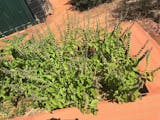The annual marigold is a very important and versatile edible tea, oil, and medicinal plant with antiseptic properties in its flowers. It has anti-inflammatory properties and accelerates tissue regeneration in wounds. The flowers are edible. Ideal for direct sowing, pot cultivation possible, sowing spring-autumn, good for mixed culture, harvesting the flowers.
Description
The marigold is a very ancient annual and important tea, oil, and medicinal plant native to Northwest Africa. It has been cultivated as a medicinal plant in Central Europe since the 12th century and is now one of the best-known garden and cultivated plants in the world. The healing power lies in the antiseptic properties of its flowers, which are sought after in both natural cosmetics and medicine. Many healing ointments and tinctures contain the special ingredients of the marigold. This special combination of active ingredients has an anti-inflammatory effect and accelerates tissue regeneration in wounds. The edible flowers bloom throughout the summer and can be used as a salad garnish, in herb butter, or to thicken soups. An insect buffet.
General information
Plant family: Asteraceae
Life cycle: Annual
Days to harvest: 100 days
Plant height approx.: 50 cm
Root type: Deep rooter
Nutrient requirements: Low
Water requirements: Low
Winter hardiness: Up to 0°C
Location: Sunny
Soil: Permeable, humus-rich loamy soil
pH value: 6 to 7
Sowing and planting information
Germination type: Dark germinator
Sowing depth: 1-2 cm
Optimal germination temperature: 12-18 °C
Germination time: 7-14 days
Plant and row spacing: 20x20 cm
Germination ability of seeds: 5-6 years
Mixed culture
Optimal mixed culture: Strawberry, Lettuce, Potato, Pumpkin, Pepper, Parsley, Celery, Tomato, Cabbage
Unfavorable mixed culture: Thyme
Sowing by climate zone
Subtropic climate (Mediterranean) (e. g. B. Portugal, Spain, Italy)
Direct sowing from February to October is recommended. The plants should ideally be planted in a sunny location.
Moderate climate (e. g. B. Germany, Switzerland, Poland)
Direct sowing from April to August is recommended. The plants should ideally be in a sunny location.
General recommendations
Direct sowing is recommended. After germination, thin out the plants to the specified plant spacing.
Marigold prefers a permeable, moderately nutrient-rich, moist and humus-rich loamy soil. Also thrives in sandy loamy soils. Doesn't tolerate waterlogging.
Additional tips
The species helps to regulate the nematode balance in the soil. Sow marigold with cabbage to maintain healthy soil for a long time. To quickly obtain a fine, crumbly and permeable soil with good nutrient and water retention capacity, it is recommended to also incorporate biochar and primary rock flour.
Type of propagation
Propagation occurs via seeds.
Plant care
Loosened, nutrient-rich soil and mixed planting are sufficient. No fertilization necessary.
Other names
Botanical names: Calendula officinalis
English names: Marigold, Calendula
German names: Ringelblume, Butterblume, Goldblume, Ringelrose, Morgenröte, Ringelbusch, Warzenkraut
Portuguese names: Calêndula
Spanish names: Caléndula
French names: Souci
Origin
Country: Portugal


![Sunflower - Yellow Trunk Form [Helianthus annuus]](http://www.benjis.net/cdn/shop/files/SonnenblumeGelbeStammform-Sunflower-Girassol-Helianthusannuus-www.benjis.net.jpg?v=1710022424&width=533)
![Chinese Chives [Allium tuberosum]](http://www.benjis.net/cdn/shop/files/Schnittknoblauch-GarlicChives-CebolinhoChines-Alliumtuberosum-www.benjis.net.jpg?v=1707958983&width=533)
![Anise [Pimpinella anisum]](http://www.benjis.net/cdn/shop/files/Anise_-_Pimpinella_anisum_-_www.benjis.net.jpg?v=1738942704&width=533)
![Valerian [Valeriana officinalis]](http://www.benjis.net/cdn/shop/files/Baldrian-Valerian-Valeriana-Valerianaofficinalis-www.benjis.net.jpg?v=1709931871&width=533)
![Borage [Borago officinalis]](http://www.benjis.net/cdn/shop/files/Borretsch-Borage-Borragem-Boragoofficinalis-www.benjis.net.jpg?v=1708551722&width=533)
![Dyer Chamomile [Cota tinctoria]](http://www.benjis.net/cdn/shop/files/Faerberkamille-Dyerchamomile-Camomiladetintureiro-Anthemistinctoria-www.benjis.net.jpg?v=1710279121&width=533)
![Rusty Foxglove [Digitalis ferruginea]](http://www.benjis.net/cdn/shop/files/BraunroterFingerhut-RustyFoxglove-Dedaleiraferrugem-Digitalisferruginea-www.benjis.net.jpg?v=1710334368&width=533)
![Lavender [Lavandula angustifolia]](http://www.benjis.net/cdn/shop/files/Lavendel-Lavender-Lavanda-Lavandulaangustifolia-www.benjis.net.jpg?v=1710362677&width=533)
![Siberian Motherwort - Marihuanilla [Leonurus sibiricus]](http://www.benjis.net/cdn/shop/files/SibirischesHerzgespann-Marihuanilla-Siberianmotherwort-Marijuanilla-Leonurussibiricus-www.benjis.net.jpg?v=1710367975&width=533)
![Evening Primrose [Oenothera biennis]](http://www.benjis.net/cdn/shop/files/Nachtkerze-EveningPrimrose-Onagra-Oenotherabiennis-www.benjis.net.jpg?v=1710418623&width=533)
![American Mountain Mint [Pycnanthemum pilosum]](http://www.benjis.net/cdn/shop/files/AmerikanischeBergminze-Americanmint-Pycnanthemumpilosum-www.benjis.net.jpg?v=1704292329&width=533)
![Apple mint [Mentha rotundifolia]](http://www.benjis.net/cdn/shop/files/Apfelminze-Applemint-Hortelamaca-Mentharotundifolia-www.benjis.net.jpg?v=1705194057&width=533)
![Artischoke Imperial Star [Cynara cardunculus var. scolymus]](http://www.benjis.net/cdn/shop/files/ArtischockeImperialStar-Artichoke-Alcachofra-Cynaracardunculusvar.scolymus-www.benjis.net.jpg?v=1705194551&width=533)
![<tc>Asian Mustard Cabbage Tokyo Bekana [Brassica rapa var. japonica]</tc>](http://www.benjis.net/cdn/shop/files/AsiaSenfgemueseTokioBekana-AsiaMustardVegetableTokioBekana-brassicarapavar.japonica-www.benjis.net.jpg?v=1704293982&width=533)
![Asian Mustard Salad Golden Streak [Brassica rapa var. japonica]](http://www.benjis.net/cdn/shop/files/AsiasalatGoldenStreak-AsiaMustardSalad-SaladademostardaAsia-Brassicarapavar.japonica-www.benjis.net-2.jpg?v=1705874556&width=533)















